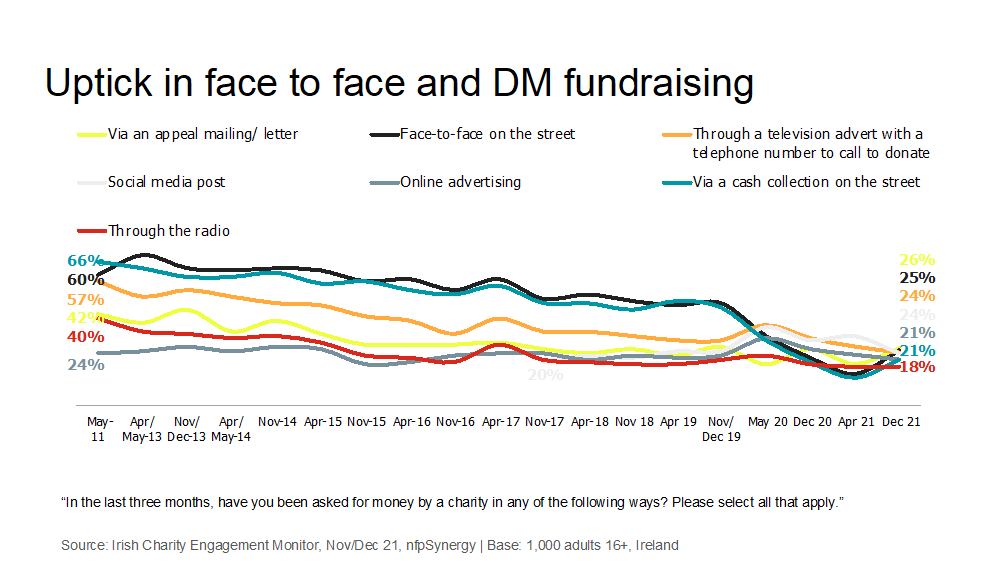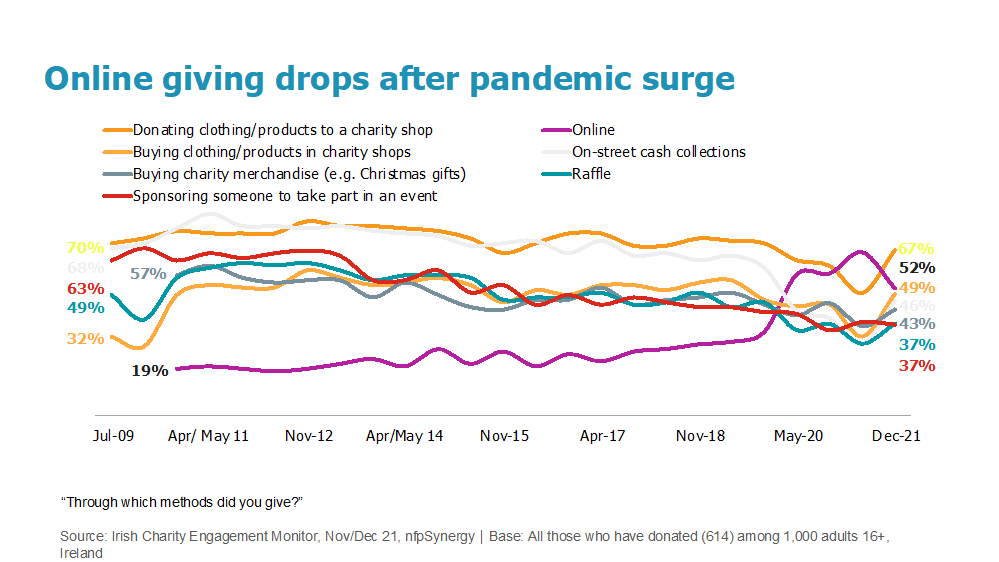How Rising Costs & Covid Aftermaths Affect Nonprofits
This is part one of a three-part policy update.
- Part two: The Sector and the State Right Now
- Part three: Enhancing the Sector’s Reputation and Reach
Funding
The general funding environment is tight and uncertain. Inflation is at historically high levels yet there is no sign yet of increased public funding being made available to compensate for these increased costs.
There is a real concern about sustained and indeed increased inflation now, coupled, since the outbreak of the Ukraine war, with an added concern of economic recession and the advent of stagflation: high inflation and low growth.
Members are worried about the impact of this on the vulnerable people and groups they support – particularly people on low and fixed incomes – in addition to fears about the adequacy of funding for their organisations’ work.
Our most recent member survey showed that half of respondents report that they do not have sufficient funding for their supports and services in 2022. This stark figure reflects the serious position many members find themselves in as a result of both the pandemic, pre-existing funding challenges that have not been addressed since the 2008 recession, and the current period of high inflation and worries about low growth.
30% of respondents told us that they currently or sometimes carry unfunded deficits from one year to the next, while a quarter of respondents hold no reserves. This further emphasises the precarious financial situation that many organisations currently find themselves in.
Even though almost 70% of our survey respondents receive statutory funding, only 15% receive multi-annual funding. More than half receive no specific contribution to the cost of overheads, compliance or governance, while more than 40% have had no increase in their statutory funding in the last three years. So there are many funding-related issues that we are working on to address in the period ahead – and keep an eye out for our pre-budget submission which will be seeking remedies for these challenges and many more.
Fundraising Trends are Complicated


Even though a funding crisis remains for some organisations, there is no clear pattern in the different experiences reported by four main categories during the crisis and persisting into 2022:
- Innovative fundraising charities have seen their income increase
- Traditional face-to-face fundraising charities have seen income decrease
- Statutorily funded organisations have seen income remain stable or increase
- Social Enterprises that earn income have seen income has increase, stay the same or decrease depending on the nature of the service provided
Our main objectives remain to secure through our budget and campaigning work:
- Multi annual funding as the norm
- Funding provided on a full-cost basis
- Sustainable terms and conditions to support staff retention and progression in publicly-funded organisations (especially in HSE-funded section 39s and Tusla funded section 56 organisations)
- Increases to the VAT Compensation scheme and other measures to incentivise and support charitable giving and major gift donations
Unfunded Compliance Load
Our most recent survey findings show that two-thirds of respondents are required to report the same compliance data to multiple sources, yet only 30% of respondents have dedicated compliance staff. We are working to encourage statutory funders to:
- Streamline compliance requirements
- Provide dedicated funding for compliance costs as part of general grants and Service Agreements/contracts
Cost of Insurance Continues to Rise
According to the Alliance for Insurance Reform (of which we are a key member) the impact of reforms to date has led to a reduction of 9% in motor premiums over the last 10 months. Liability premiums (the premiums that have caused the current crisis for members), however, continue to rise, by an average of 16%. Liability premiums will not fall to affordable levels unless five things happen:
- General damages for minor injuries must be dramatically reduced for good.
- Re-balance the “common duty of care”.
- Reform of the Personal Injuries Assessment Board. Draft legislation to reform PIAB has been published. The Alliance has welcomed the proposed legislation with some reservations - Now the Government must get a move on with enacting it.
- Reduce insurance costs. The impact of the new personal injury guidelines, the launch of the Garda Insurance Fraud Coordination Office and the commencement of the Perjury Act should have been immediately passed on to policyholders by incumbent insurers, but they weren’t.
- Increase Insurance Competition. Over 40 sectors are now unable to get insurance cover or are down to one underwriter. We expect Minister Sean Fleming’s Insurance Competition Office to get new underwriters into the Irish market urgently.
Recruitment and Retention Crisis and Lack of Pay and Condition Equivalency
There is a recruitment and retention crisis in the sector with boards finding it challenging to fill positions vacated by staff to moving to better remunerated posts in public and (increasingly) private sectors. Related to this crisis is the crisis of pay and conditions in the sector which are now in danger of falling even further behind those in the public sector (the usual comparator for pay equivalence on the principle of like pay for like work).
There is an increased likelihood of industrial unrest for some organisations. Restoring the informal yet effective pay-equivalency annual-increase funding link with the public sector (severed in 2009 as a result of the 2008 crisis) is viewed as an imperative by many members. To repeat here – our main objectives are sustainable terms and conditions to support staff retention and progression in publicly-funded community and voluntary organisations.
Challenge Re-Engaging Volunteers
Many volunteer-involving members are reporting challenges re-engaging cohorts of volunteers – and there is concern that there may be a period of real difficulty returning to “normal” in-person, or even “hybrid” activity in the post-Covid world. There is a big “re-engagement” challenge, and the sector will have to work hard with the department of Rural and Community Development to ensure that the National Volunteer Strategy identifies the scope and scale of the challenge and devises solutions to attract volunteers back to the crucial operational and governance work they do. Without volunteers the community and voluntary sector cannot survive.
